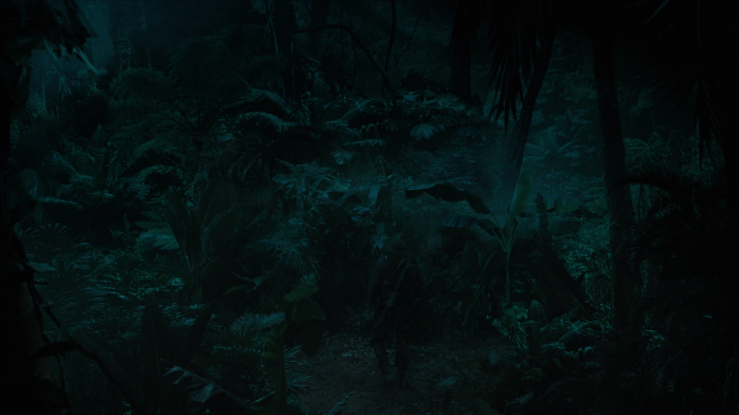
I enjoyed Season 3 of True Detective, and thought the season finale, which aired last night on HBO, was especially good. Like the season as a whole, this eighth episode, “Now Am Found,” was rich, sad, ironic, often menacingly sinister, and ultimately ambiguous. “Now Am Found” showed that, like the two seasons that preceded it, True Detective’s third season was ultimately not about the criminal investigation purportedly at its center. Rather, True Detective is about the people who investigate the crimes, and how the investigations impact their relationships.
Three relationships drive the third season of True Detective: the relationship between Detective Wayne Hays (Mahershala Ali) and his partner Detective Roland West (Stephen Dorff); the relationship between Hays and his girlfriend and then wife Amelia Reardon (Carmen Ejogo); and the strange relationship between iterations of Hays himself, primarily versions of himself from 1980, 1990, and 2015. Like Season 1 of True Detective, Season 3 employs multiple timelines, often to a purposefully confounding effect.
Looping timelines are part of True Detective’s DNA. In Season 1, Rustin Cohle (Matthew McConaughey) proclaims that “time is a flat circle,” paraphrasing Nietzsche’s idea of eternal recurrence. Our souls will infinitely repeat everything we have ever done or will do. Season 3 dramatizes Cohle’s proclamation via its viewpoint character, Wayne Hays, who is, to borrow a phrase of Kurt Vonnegut’s “unstuck in time.” Hays is in the early stages of a creeping dementia in the 2015 timeline, and throughout the series his consciousness veers between the years.
In 1980, Hays and West begin investigating the murder of Will Purcell and the kidnapping of his sister, Julie Purcell. Hays also meets his future wife Amelia in this investigation. In 1990, a second investigation into the Purcell case is under way; Hays and West attempt to right some of the wrongs that went down in the 1980 case. In 2015, Hays and West initiate a third Purcell investigation (not letting the fact that they are no longer police officers stand in their way). True Detective Season 3 unspools, tangles, and ties these threads into a bewildering and often thrilling tapestry, ultimately depicting a man whose mind is falling apart.
Like the episodes before it, “Now Am Found” dips freely from timeline to timeline. However, this final episode is bookended by two scenes that deviate from the main 1980-1990-2015 plotlines. The opening scene seems to be set a few years after 1990—perhaps in ’94 or ’95. Amelia is teaching English at the University of Arkansas, where Hays is now the head of campus security. In an idyllic moment that restages their initial meeting in 1980, Hays sticks his head into Amelia’s classroom to hear her read a bit of Delmore Schwartz’s poem “Calmly We Walk through This April’s Day.” This moment is the only glimpse we get of this timeline, a timeline that Amelia and Hays promise to create for themselves roughly half way through “Now Am Found.” In a scene that caps the end, or an end (there are no tidy ends in True Detective) to the 1990 timeline, Amelia and Hays agree that their relationship has been inextricably bound up in the Purcell case; their partnership’s genesis was rooted in murder and mystery. They elect to start anew, to write their own conclusion. The episode’s beginning delivers this conclusion, an ironic inversion that represents the season’s approach to linear time.
The second scene that deviates from the 1980-1990-2015 plotlines is the very last shot, which I will come to momentarily. First though, let me address the third-to-last and second-to-last scenes (which, after all, is what this blog’s title promised).
The season’s third-to-last scene comes after Hays follows one last lead as to where Julie Purcell might be. The lead comes from a vision of Amelia (prompted by reading a snippet of the true crime book she wrote about the case, which Hays has never fully read). The vision is a phantom, a ghost emanating from his own consciousness, and it directs him to write another conclusion in the Purcell case—a happy ending with a family restored. However, when Hays finally makes it to the woman whom he believes is Julie Purcell, his dementia undoes him. He calls his son, who arrives along with Hays’ daughter, to bring the old man home. Hays hands over the last clue to the Purcell case—the address he drove to—to his son, who is also a detective. The loop remains open.
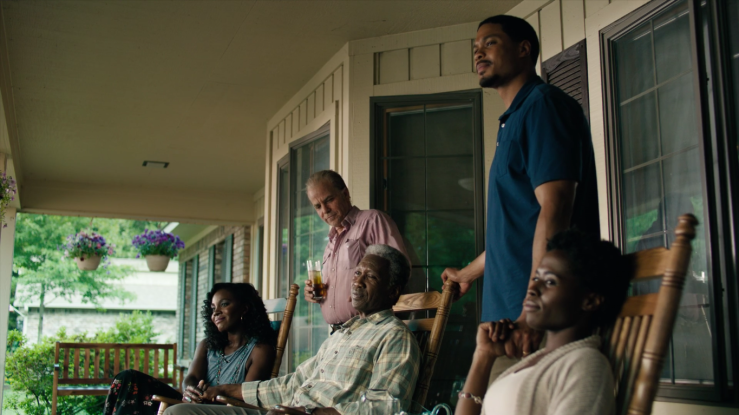
Hays and his grown children return to Hays’ son’s house. This third-to-last scene plays out as a glowing, bright fantasy of familial reconciliation, extending that reconciliation to Hays’ once-estranged partner West. The family (including West) gaze on their children from the porch, iced teas in hand, rocking softly, their hands touching. It’s almost too godddamn corny for words.
The scene swells with menace though. The sun promises to set, and we pan to a shot of Hays’ grandchildren, boy and girl on bikes. The shot echoes the first episode’s shots of Will and Julie Purcell riding their bikes into the night, into peril. Hays will never get outside of the circle in which his consciousness is circumscribed.
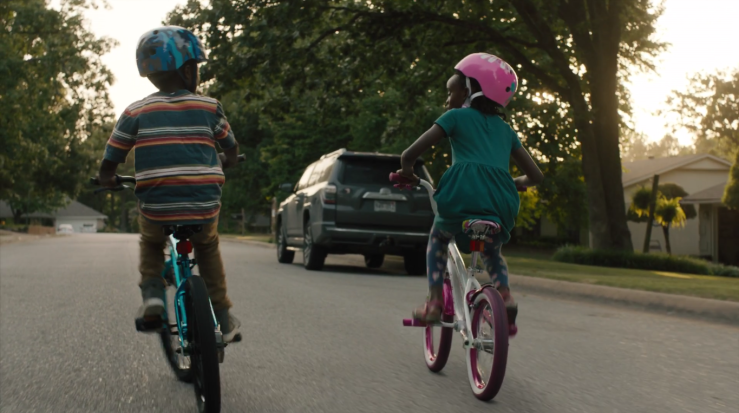
Through Hays’ consciousness we depart the scene entirely. In a fantastic shot, we see Hays’ face submerge into time. Mahershala Ali is excellent in True Detective Season 3, and his eyes are especially expressive, signalling shifts in consciousness, in realization and unrealization.
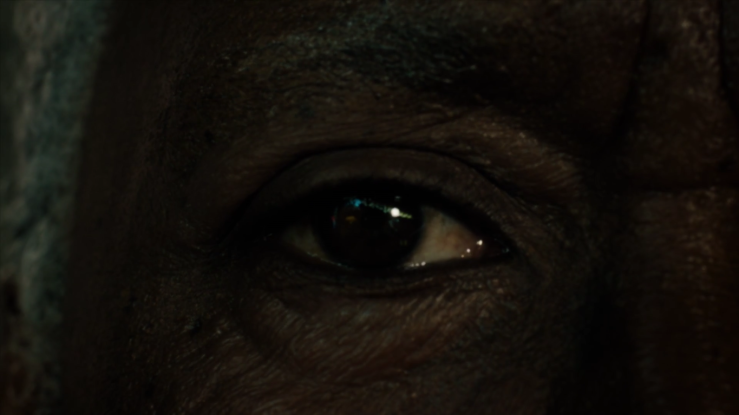
The third-to-last scene transitions to the second-to-last scene through Hays’ eyeball. We end up at the VFW bar, all the way back in 1980, to reconcile with the person missing from the family reunion depicted in 2015: Amelia.
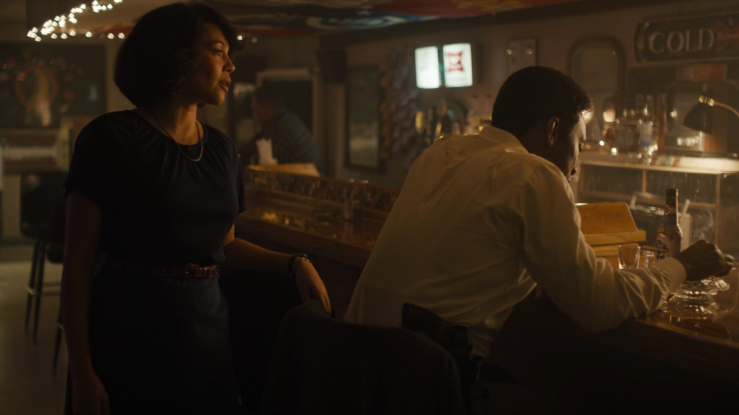
Amelia, like West, was both partner and rival to Hays. Their partnership seemed doomed after the fallout of the 1980 investigation. Amelia, also a true detective, authors an article that damns Hays’ career. This point of resentment boils throughout the season, particularly during the 1990 strands; resentment and competition are seeded into their partnership. And yet when Amelia arrives at the VFW bar, searching for a resolution, a conclusion if not a reconciliation, she opens something new in Hays, who cries before her and then asks her to marry him. The two exit into a glowing light, off to repeat their parts in a circle to which the viewers have already borne witness. This scene too is coded in subtle irony. Their new beginning will not set them free from the arc of their circle.
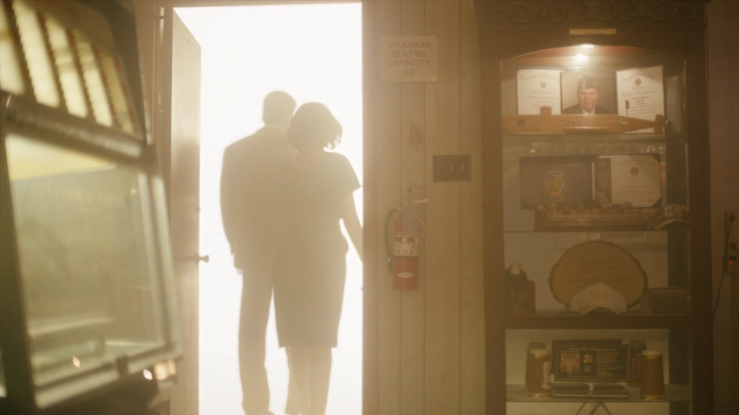
The light resolves into darkness, and we find ourselves some place utterly new yet wholly recognizable. Amelia is gone; the family is gone. This scene is Hays alone, somewhere in the jungles of Vietnam. It’s likely some time around 1965. Hays turns and looks directly toward the camera, but also, perhaps, directly at some version of himself, some version from 1980, 1990, 2015. He seems to gaze forward at the eye that gazed backward at him from half a century in the future.

Wayne Hays then turns and walks into the enveloping jungle. He disappears. Season 3 of True Detective is over.
The moment that Hays disappears into a Vietnamese jungle is ambiguous, sure. But given True Detective’s formal thesis that “time is a flat circle,” we can also read this ending as a suggestion that Hays is bound to repeat his arc. The Vietnam War is in many ways the founding unaddressed trauma of Hays’ life, and the series in a bleakly ironic gesture puts him right back there at the ending.
The title of “Now Am Found” clearly alludes to “Amazing Grace,” but the episode’s events ironically show that Hays can never be found. True, there are momentary gestures of reconciliation, of “being found” — by his son and daughter, by Amelia, by his partner West — but Hays is a consciousness in fragments, a kind of damned loop of a person suffering through a purgatory he doesn’t fully have the language to describe, let alone communicate to another person.

Some viewers may have found the final shot of “Now Am Found” bewildering, inexplicable, or unnecessary. I thought it was a sad, rich image that provided a vital coda for a sad, rich television show. The final image serves to reinforce the series’ trope of eternal recurrence, undoing (or, more charitably simply complicating) the episode’s opening scene, in which we saw a peaceful, happy Hays and Amelia. But if the final scene in Vietnam undoes the domestic bliss that Hays and Amelia authored for themselves, it also points to the promise of futurity, of a future that goes on and on and on.

Enjoyed your posts about the show. Every time I come across the flat circle quote I’m reminded of when my young son piped up and said, but dad, all circles are flat. I tried to tell him about poetic license but he was not buying it. Just say time is a circle, he said, if that’s what you’re trying to say.
LikeLiked by 1 person
Good blog. I have questions. What happened to Amelia? And why did Roland want to get beat up or just wanted to get into a fight? Just hurting?
LikeLike
Roland: I think the scene from Roland highlights the season’s themes of crimes without punishment. Roland has just committed a murder, which he says (and I’m probably misquoting, but the gist is there) has “ruined” his life. His partnership with Wayne will also disintegrate because of the murder. Picking a fight he knows he can’t win is a form of punishment. The punishment theme is enforced when Juney (sp.?) pleadingly yells, “Punish me” to the two detectives in 2015. They walk away. Wayne, of course, is punished by ten years of desk purgatory, and then another life time of purgatory trapped in memories that never fully cohere.
Amelia: Obviously, her being dead is part of the plot’s structure—she needs to be a ghost in Wayne’s conscience for the plot to work. The series never fully disclosing the circumstances of her death is another ambiguity. My sense however is that she has died somewhat “recently” — sometime somewhat close to 2010. The opening scene of “Now Am Found” shows a kind of second, or really third life for Wayne and Amelia, and I think that that scene suggests a “happy ending” of sorts, albeit one that’s ultimately foreclosed upon by something like, I don’t know, cancer—something awful but also ordinary. No murder, no tragic accident—just the kind of thing any loving couple might have to face later in life.
LikeLike
Saw your post. Realized the season was finished and watched it all, finishing late in the night. I couldn’t quit watching. There were moments of great tension, horror, joy, etal. I do love S02, but… this is a more appropriate follow up, I believe. Great, great season I’m going to revisit, S03. I need to revisit S02, again as well. I love the show. S01 is one of my favorite pieces of media, period.
LikeLike
A few objections,
-I don’t think this season has any serious connection to Rust’s paraphrasing of Reggie LaDoux’s paraphrasing of Nietzche. You could make a stronger case for Ani’s line about memories remembering you relating to S3s striking scene transitions. And Ray Velcoro much more embodies a literal eternal recurrence being told he’s lived hundreds of lives and his death is predestined
-The scene at the start takes place much later than 1994 or 1995 as it’s the same era Wayne brought Becca to college at the start of episode 7.
-“The two exit into a glowing light, off to repeat their parts in a circle to which the viewers have already borne witness. This scene too is coded in subtle irony. Their new beginning will not set them free from the arc of their circle” On the contrary – we *know* it sets Wayne free from his arc for rest of his life with the brief exceptions of 1990 and 2015
-“But given True Detective’s formal thesis that “time is a flat circle,”” Yeah, I don’t think that’s the thesis of more than maybe a single episode or two in S1
-“we can also read this ending as a suggestion that Hays is bound to repeat his arc. The Vietnam War is in many ways the founding unaddressed trauma of Hays’ life, and the series in a bleakly ironic gesture puts him right back there at the ending.” I wouldn’t call it a trauma. It is a formative experience for sure – but it’s not much different than any other dangerous solitary career re: it’s effects on Wayne other than the fact that many Vets do transition straight to PDs when they come home. He’s not Woodard
-“But if the final scene in Vietnam undoes the domestic bliss that Hays and Amelia authored for themselves” My read was the complete opposite. The final scene is a meditation on Wayne as a young man – alone – waiting to die (as he mentioned to Amelia) – secure – doing what he’s told. What a triumph to shed that limiting psychology from 1980 to 1990. Only by having done so is Wayne able bring together efforts of Roland, Amelia, and Henry to finally solve the case
LikeLike